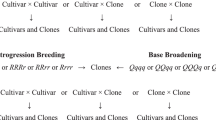Summary
In a field study simulating commercial practice, the performance of 4x meiotic tetraploids from 4x−2x crosses (Group Tuberosum×(Group Phureja×haploid Group Tuberosum), and their 4x and 2x parents, was studied for total yield, total number of tubers, number of marketable tubers and average tuber weight. Some of the families showed striking heterotic effects for these characters. 38 selected high yielding tetraploids from these families, when evaluated in the next season, gave 80% higher mean yield than the mean of the 4x parents.
Similar content being viewed by others
References
Gaur, P. C., Jai Gopal & M. S. Rana, 1983. Combining ability for yield and its components and tuber dry matter in potato.Indian Journal of Agricultural Sciences, 53: 876–879.
Hermsen, J. G. Th., 1983. New approaches to breeding for the potato for the year 2000. In: W. J. Hooker (Ed.), Research for the potato in the year 2000. International Potato Centre, Lima-Peru, pp. 29–32.
Hermsen, J. G. Th., M. S. Ramanna & K. E. Jongedijk, 1985. Apomictic approach to introduce uniformity and vigour into progenis from true potato seed (TPS). In: Present and future strategies for potato breeding and improvement. International Potato Centre, Lima-Peru, pp. 99–114.
Jong, H. de & G. C. C. Tai, 1977. Analysis of tetraploid-diploid hybrids in cultivated potatoes.Potato Research 20: 111–121.
Jong, H. de, G. C. C. Tai, W. A. Russell, G. R. Johnston & K. G. Proudfoot, 1981. Yield potential and genotype-environment interaction of tetraploid-diploid (4x−2x) potato hybrids.American Potato Journal 58: 191–199.
Mendiburu, A. O., S. J. Peloquin & D. W. S. Mok, 1974. Potato breeding with haploids and 2n gametes. In: K. J. Kasha (Ed.) Haploids in higher plants; advances and potential. University of Guelph, Guelph, p. 249–258.
Mendiburu, A. O. & S. J. Peloquin, 1977. The significance of 2n gametes in potato breeding.Theoretical and Applied Genetics, 49: 53–61.
Mok, D. W. S. & S. J. Peloquin, 1975. Breeding value of 2n pollen (diplandroids) in tetraploid×diploid crosses in potatoes.Theoretical and Applied Genetics 46: 307–314.
Peloquin, S. J., 1983. New approaches to breeding for the potato of the year 2000. In: W. J. Hooker (Ed.), Research for the potato in the year 2000. International Potato Centre, Lima-Peru, p. 32–34.
Author information
Authors and Affiliations
Additional information
Publication No. 997, CPRI, Simla.
Rights and permissions
About this article
Cite this article
Birhman, R.K., Garg, K.C. Yield and yield components of meiotic tetraploids of potato. Potato Res 32, 457–462 (1989). https://doi.org/10.1007/BF02358501
Accepted:
Issue Date:
DOI: https://doi.org/10.1007/BF02358501




